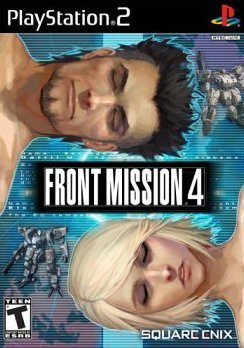Front Mission 4
Front Mission 4 is the 4th Game in the Front Mission Strategy RPG series. Once again, you control a squad of giant robots.
Front Mission 4 Overview
Front Mission 4 is the fourth installment in the Front Mission franchise and was originally released in late 2003 in Japan and early 2004 in North America. Players control multiple giant robots called wanzers in a tactics style combat system. While still a linear game design Front Mission 4 returns to its roots by making the game very similar to the previously released Front Mission 2. Added in this new installment was ammo and the ability to attack multiple times in a single combat. This game has a lot to offer fans of the strategy role playing game genre, but leaves a lot to be desired for new players.
Front Mission 4 Screenshots
Front Mission 4 Featured Video
Front Mission 4 Review
For games featuring giant robots, the Front Mission series isn’t very flashy. Of course, what it lacks in presentation it compensates for with intricate gameplay and complex plots. Front Mission 4 is hardly an exception, with long tactical combat and international conspiracies coming from every direction.
Now, although I say that Front Mission 4 isn’t flashy, this doesn’t mean it looks bad. The visuals are actually fairly nice, with convincingly life-like animation for the wanzers (giant robots which comprise for the vast majority of enemies and allies in the game). Mind, if you don’t care for looking at wanzers all day, Front Mission 4 might not be for you, because you rarely, if ever, see characters out of them. Then again, it’s animating humans that tends to make CG work look ‘fake’, so it’s not a bad tradeoff at all. Also of note is that it’s common for the story to be told with still screens- that is, simple backgrounds rather than real cut-scenes. While this does tend to make sure you have little to pay attention to aside from the dialogue, it also makes things a touch duller than they could be.
It would help if the game spiced up such scenes with voice acting, but this too is used sparingly. The voice acting is quite good when it is used, too, making one miss it all the more. The music isn’t as noteworthy, but it’s not bad either. Really, the best word for the music is appropriate; it fits the general feel of the different missions very well.
Which is good, because in general completing a mission in Front Mission 4 takes a long time. Too long for a player who isn’t well versed in Strategy RPGs, actually. Perhaps someone with a better mind for strategy would fare better, but I often found myself spending 20 minutes on battles in the simulator. To say nothing of the first boss fight stretching well over 45 minutes, which is crazy. That said, a basic tactical system; each wanzer has different numbers of spaces it can move, and different attacks have various ranges. Adding to this, each weapon consumes a differing amount of Action Points (AP). Each space moved also consumes 1 AP. Each wanzer regenerates a different number of AP per turn, so the player must consider how much they use, how far they can move and still attack, whether they can hit the enemy, and the like. Additionally, assuming the target has sufficient AP and is in range with their current weapon, when attacked it will counter attack, thus increasing the importance of using range well and conserving AP. And while all this is probably appealing to an SRPG buff, to me it made battles that were simply too long.
More interesting was character building. Successful battles grant, among other things, EP. EP is used to buy skills for your characters, ranging from increasing their AP, to buffing their proficiency with certain weapon types, to giving them skills like Rapid Fire, which randomly increases the damage dealt by your weapons. Each character has set abilities they can learn, but the player chooses what order they are learned in, meaning that if some skills seem unimportant, you don’t have to waste EP on them. There’s also something very satisfying in boosting, via skills and equipment, a character’s evasion to 60%.
Similarly complex, yet more satisfying for me, was the storyline. Front Mission 4 starts with Elsa, a young woman recruited into a wanzer research group called Durandal. As a group affiliated to all of Europe, they are asked to investigate a series of attacks on German military bases. However, it quickly becomes apparent that this is hardly a random act of terrorism. Not long after, the narrative suddenly switches to Darril, a soldier of the United Confederation of States (think of North and South America forming one big union) fighting against the insurgent State Army of Venezuela, at least in theory. However, he’s really not a soldier at heart, and willing to take any opportunity that would let him live on his own. And then that opportunity comes in the form of secret cargo for the Governor of Venezuela. Eventually these two stories come together, unlikely as it may seem, and a tale of international conspiracy is woven.
The journey is also all the more enjoyable because of the diverse personalities surrounding both Elsa and Darril. The character interaction in Front Mission 4 is quite good, adding much-needed zest to the cut-scenes. There’s even a good chance you’ll find yourself laughing at times.
Overall, though, Front Mission 4 proved a very dry game. Not truly boring, but far from exciting. If you aren’t a big fan of Strategy RPGs, I’d strongly recommend giving the game a rental before buying. If you are, though, there’s absolutely no reason not to get the game.
Final Grade: 75%
Front Mission 4 Videos









